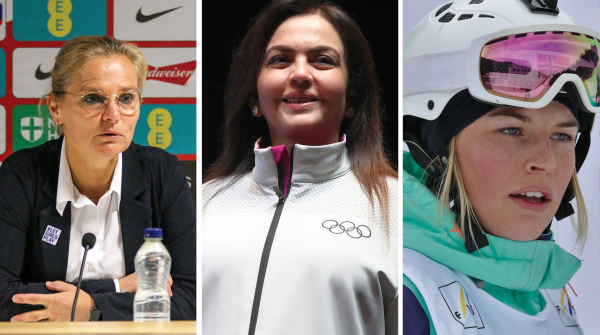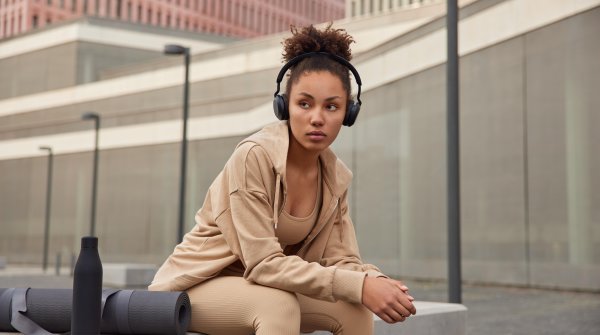After my padel premiere, my partners want to know if I already play another backstroke sport. I don't. And I don't - at least not to any significant extent. This question, which is meant as a compliment, is not intended to prove that I am a natural padel player. Rather, it is meant to show that you can achieve your first successes in padel very quickly if you enjoy movement and new challenges. But the first rallies were anything but promising.
I stepped onto a padel court for the first time at the German Padel Open in Düsseldorf. In the run-up to the quarter-finals, people in charge from the scene meet for a small session in the "We Are Padel" centre. Bright blue flooring on the floor, heavy curtains between the courts, powerful lighting from the ceiling. From the depths of the hall, the echoing "pock" of felt balls on plastic drifts over.
From a comfortable seat between the store and the bar, I follow the matches in front of me. When a player comes over from one of the back seats for a breather, someone presses a racket into my hand. My bet.

Depending on the model, a padel racquet weighs just under 400 grams, which is somewhat less than one might expect from its somewhat chunky appearance. The balls can hardly be distinguished visually from tennis balls. However, they are a bit smaller than their relatives and have less air pressure, so they don't fly around your ears quite as fast.
Speed, however, is the least of my problems at the beginning. My punches have a considerable spread. If I lack body tension, the balls end up in the net. If I'm too good with the power, the felt projectiles thunder right into the opposite glass wall. Do my padel partners regret letting me on the court at this point?
Little by little, the first progress becomes apparent. Sometimes a beautifully placed ball, sometimes a volley ... A successful lob earns me my first appreciative glance.
"Padel is a great sport, anyone can start playing it," Manuel Gómez tells me later. "You tried it for the first time today and after three rallies you already got a feel for the ball, so we could play longer rallies. I think there's hardly a sport that's so easy to learn."
Manuel is not only a padel coach, but has also recently gone online with the store "Padel DNA". In Germany, Manuel has identified great potential for growth. "The market is not that big at the moment. At the moment there are less than 500 padel courts. But we know that this is set to change. This results in good potential for the trade in rackets and equipment." He said growth in Germany is not as big as in other countries, but it is stable. "We believe it is the right time to start with our company."
Padel DNA's slogan is "It's in our blood". And after the first few rallies, I can confirm that the enthusiasm for the sport is slowly mixing between erythrocytes and leukocytes in my bloodstream as well. With various commands, my teammates - all of them Spanish - make it very easy for me. "You! You!" they say when I'm supposed to go to the ball. In between, they direct me to the right spot on the court.
"One of the challenges of padel is to develop a feeling for where to stand on the court, when and where to move," Manuel explains. "If you have good technique but don't know where to run, it doesn't work."
By the way, the different commands are not only important for me as a beginner, but for all levels, from advanced to professional. Padel is a team sport. If a ball is played very high, for example, you can concentrate fully on the yellow ball before hitting it, while your partner keeps an eye on what's happening beyond the net. "Is the opponent in front? One? Both? With this information, I help my partner make a decision," Manuel describes. "So my teammate's eyes and communication with each other are very important."
At least as important - and I quickly realize this - is patience. If you're not used to the limitations of the playing field from squash, you'll probably instinctively try to reach the ball before the wall at any cost. But this tactic doesn't work. After a few near crashes with the perimeter and warning cries of "Caution!" from my Spanish padel partners, I take it easy. And indeed. If you give the ball the chance to drip from the glass back into the field, it is often followed by a clean shot.

"The walls around you are the second big challenge," Manuel says. "You have to think about them every second. If you can make the walls become your friends, you'll be able to reach a very good level."
I haven't completely taken the surrounding glass to my heart yet, but as the match progresses, our relationship begins to make progress. In the end, it doesn't come to the final fraternization. Between concentrating on the correct positioning on the field and the joy of successful rallies, I forget to count the points. The end of the game therefore comes abruptly and much too soon. A hearty high-five, a nice chat, and we're off the court.
At least I had the racket in my hand long enough to really get a taste for padel. I only find out later that there are only a few facilities in Germany. In addition, the available courts are often booked up long in advance. But according to forecasts, the number of courts will have doubled by next year. By then, at the latest, I hope to be on the court more often - and deepen my still tender friendship with the glass walls.

Victoria, you are a multiple Spanish padel champion. You and your partner Claudia Fernández Sanchez played in Germany for the first time at the German Padel Open. How did you like it?
I really enjoyed the tournament overall, only the music between the rallies took some getting used to for us players. But it was certainly interesting for the spectators.
You normally play in front of a larger audience. How did you perceive the atmosphere here in the hall?
I try not to focus so much on the fans, but rather on the game. But I feel more pressure when there are more people there. Then I'm a bit more nervous. Everything was pretty relaxed here in Düsseldorf.
How strenuous is a professional padel career overall?
It's been a long road for me to get here. I've been playing since I was a child. Of course, daily training is part of it, but the effort is mainly mental. You have to say goodbye to your family and friends for many days. You need a strong will to concentrate on the game and not miss your family too much.
You are currently ranked 19th in the world rankings. Can you make a good living from padel as a professional?
If you're not in the top 20, you can make a living from padel, but you'll probably have to do without some things. It always depends on the sponsors. The top 20 players can make a pretty good living from padel.
Do you always have to sign autographs as soon as you leave the house?
It depends on where I'm going, which country I'm in and what the atmosphere is like there. When padel fans are there, a lot of them actually ask for autographs and pictures. But if I go to a restaurant, for example, where there aren't so many fans, I have my peace and quiet.
Look forward to action-packed moments in the Padel Village in Hall B3, where top-class players will be playing exciting matches - and you know what? Trade visitors like you can swing the paddle yourself! In addition to the courts, you can discover and try out the right equipment from brands such as Adidas, Aeon, AllPadel, Drop Shot, Inyerasp, Okatent, Playtomiv and Skechers!
Get ready, because ISPO Munich 2023 is turning into an epic padel mecca!
- Awards
- Mountain sports
- Bike
- Fitness
- Health
- ISPO Munich
- Running
- Brands
- Sustainability
- Olympia
- OutDoor
- Promotion
- Sports Business
- Textrends
- Triathlon
- Water sports
- Winter sports
- eSports
- SportsTech
- OutDoor by ISPO
- Heroes
- Transformation
- Sport Fashion
- Urban Culture
- Challenges of a CEO
- Trade fairs
- Sports
- Find the Balance
- Product reviews
- Newsletter Exclusive Area
- Magazine








